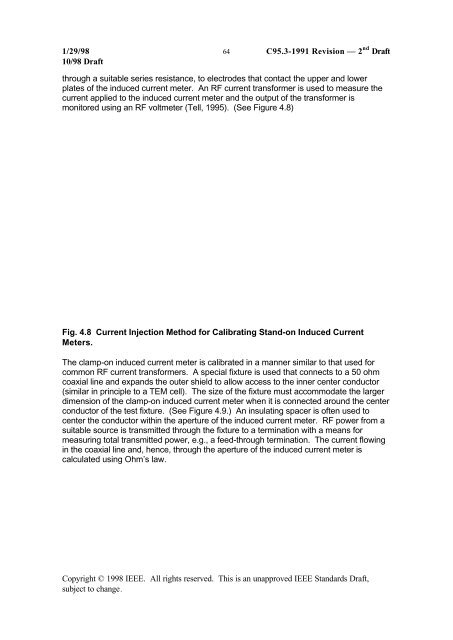DRAFT Recommended Practice for Measurements and ...
DRAFT Recommended Practice for Measurements and ...
DRAFT Recommended Practice for Measurements and ...
You also want an ePaper? Increase the reach of your titles
YUMPU automatically turns print PDFs into web optimized ePapers that Google loves.
1/29/98 64 C95.3-1991 Revision — 2 nd Draft<br />
10/98 Draft<br />
through a suitable series resistance, to electrodes that contact the upper <strong>and</strong> lower<br />
plates of the induced current meter. An RF current trans<strong>for</strong>mer is used to measure the<br />
current applied to the induced current meter <strong>and</strong> the output of the trans<strong>for</strong>mer is<br />
monitored using an RF voltmeter (Tell, 1995). (See Figure 4.8)<br />
Fig. 4.8 Current Injection Method <strong>for</strong> Calibrating St<strong>and</strong>-on Induced Current<br />
Meters.<br />
The clamp-on induced current meter is calibrated in a manner similar to that used <strong>for</strong><br />
common RF current trans<strong>for</strong>mers. A special fixture is used that connects to a 50 ohm<br />
coaxial line <strong>and</strong> exp<strong>and</strong>s the outer shield to allow access to the inner center conductor<br />
(similar in principle to a TEM cell). The size of the fixture must accommodate the larger<br />
dimension of the clamp-on induced current meter when it is connected around the center<br />
conductor of the test fixture. (See Figure 4.9.) An insulating spacer is often used to<br />
center the conductor within the aperture of the induced current meter. RF power from a<br />
suitable source is transmitted through the fixture to a termination with a means <strong>for</strong><br />
measuring total transmitted power, e.g., a feed-through termination. The current flowing<br />
in the coaxial line <strong>and</strong>, hence, through the aperture of the induced current meter is<br />
calculated using Ohm’s law.<br />
Copyright © 1998 IEEE. All rights reserved. This is an unapproved IEEE St<strong>and</strong>ards Draft,<br />
subject to change.
















